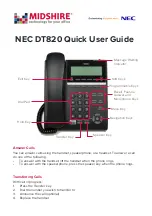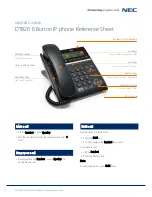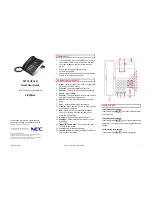
b. Enabling/Disabling Central Station Mode
The
1600A
Series emergency phone can be placed in the “Central Station Mode” by entering a central station phone num-
ber in position
#05
while programming. To cancel the “Central Station Mode,” clear position
#05
by entering
#05
only (see
Programming
section
D
).
c. Ring No Answer
When the
1600A
Series emergency phone is in the “Central Station Mode”, it is best to have the ring no answer set to a min-
imum of three, because some receivers send a long tone after answering the line that sounds like a ring back. If the
1600A
is set to a ring no answer of two, the phone will disconnect (see
Programming
section
F
).
a. Accessing the Programming Mode
Before programming, you must access the programming mode (see
Programming
section
A
).
1. Central Station Programming Features
To Program the 1600A Series Phone...
...to enable central station programming and dial 952-2567
...to disable central station programming
Step 2 - Enter Digits:
9 5 2 2 5 6 7 # 0 5
# 0 5
Step 1:
Enter Programming
Enter Programming
10
The standard
1600A
emergency phone is capable of communicating using the “Ademco Contact I.D.”, “Ademco High Speed”, “DTMF
4+1 Express”, or the “DTMF 4+2 Express” formats. All formats use the programming memory location
#20
to store the account code
and alarm details.
K. Central Station Programming
Speaker
Volume
ON
OFF
ON
OFF
1 2 3
A
B
Standard
OFF ON
EWP
A B
Standard
OFF ON
1
2
3
EWP
J. DIP Switch Programming/Speaker and Microphone Adjustments
DIP
Switch
1
1
2
2
3
3
Position
ON
OFF
ON
OFF
ON
OFF
Description
“HELP” / “CALL” button alternately connects
and disconnects calls (factory default)
“HELP” / “CALL” button connects calls only
Incoming calls answered (factory setting)
Incoming calls are not answered
Normal operation mode (factory setting)
Learn mode - Any incoming calls are automatically entered
into the programming mode (no security code required). Use
this option if you have forgotten your security code. Any out-
bound call will dial Viking Technical Support (see section
I
).
Warning: When finished programming, set this switch
back to the ON position, otherwise the 1600A Series
phone will only call Viking Technical Support instead of
your programmed emergency number.
Switch
A
ON
OFF
Description
Normal audio detection
Increase audio detect sensitivity for low level lines. Useful
in applications in which voice or busy signals have trouble
breaking over the speaker.
Switch
B
ON
OFF
When attempting to program the 1600A Series emergency phone, if the phone number of the line it is connected to is not known,
the phone can be set to automatically call Viking technical support for assistance. With DIP switch 3 set to OFF (programming mode),
pushing the CALL button will cause the
1600A Series
phone to call Viking, whether it be connected directly to a CO line, or behind
a "dial 9" PBX.
The
1600A Series
phone will first dial 9, and then listen for second dial tone; if detected it will continue to dial Viking’s assisted pro-
gramming phone number. If a second dial tone is not detected, it then knows is not behind a PBX, so it will momentarily hang up
and then directly dial Viking’s assisted programming phone number. Since this is a long distance phone call, the line must be capa-
ble of placing long distance calls for the call to go through. When finished programming, it is very important to set DIP switch 3 back
to ON (normal operating mode), and place a test emergency call to be sure all programming was done properly.
Warning: Failure to set DIP switch 3 back to ON when finished programming will cause the 1600A Series phone
to only call Viking Technical Support, instead of your programmed emergency number.
I. Assisted Programming
A speaker volume POT is provided to increase or decrease the speakerphone volume.
Note:
The Microphone Sensitivity POT has been removed
because the microphone sensitivity is now microprocessor controlled. This allows the mic gain to be automatically increased in a quiet environment,
allowing the distant party to clearly hear even soft or distant sounds. The microprocessor will automatically reduce the mic sensitivity when the loca-
tion becomes noisy. This Automatic Noise Canceling (ANC) feature will allow speakerphone two-way communications to continue to work properly,
even when subjected to loud noise such as a diesel engine or traffic.






























